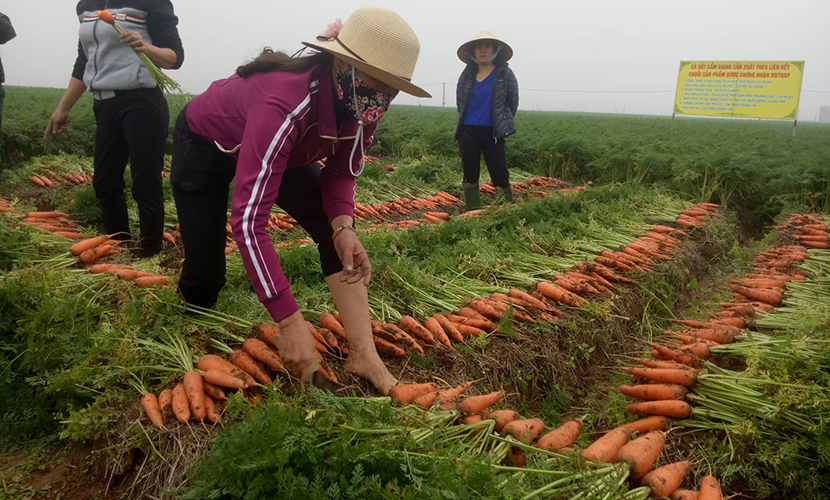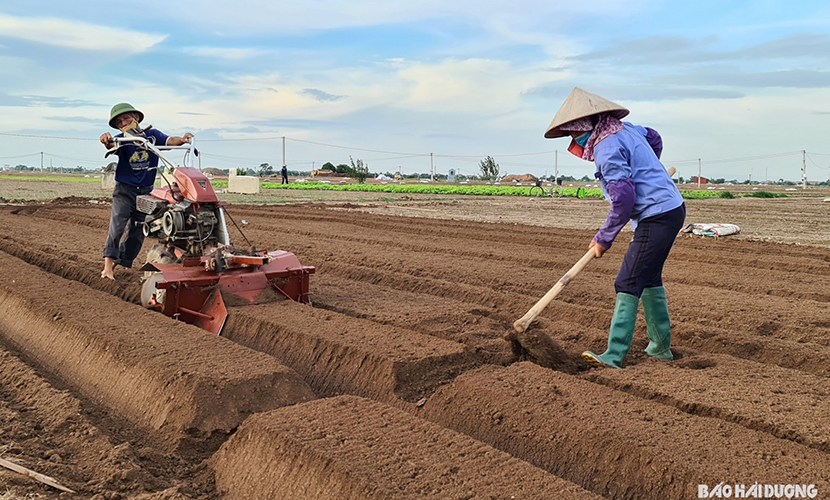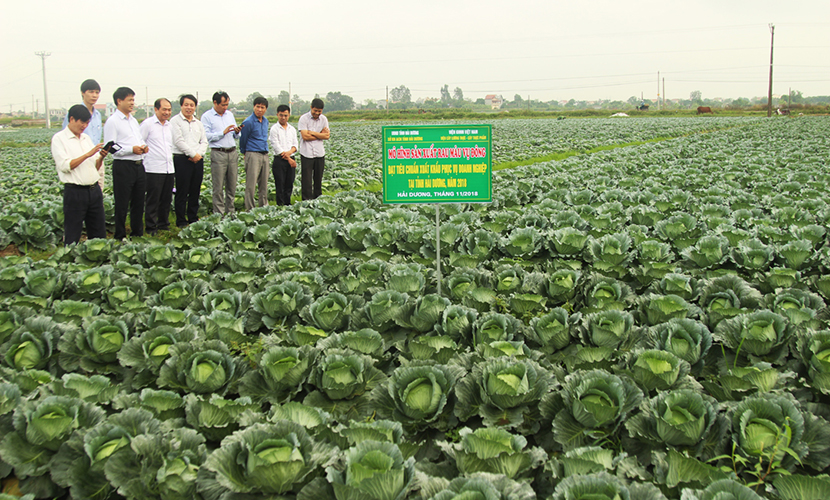
In recent years, the winter crop in Hai Duong province has consistently maintained a cultivation area of over 22,000 hectares for Vietnam’s fresh vegetables. Evaluations show that the productivity of most crops increases annually or remains on par with the previous winter crop season.
Key crops such as onions, garlic, carrots, cabbage, and tomatoes are being widely cultivated by the farmers of Hai Duong. Notably, some winter crops are available to numerous countries around the world, bringing high income to local farmers.

Prepare for carrot seeding
A highlight of Hai Duong’s winter crop production is the export of Vietnam’s fresh vegetables, particularly carrots and cabbage. Duc Chinh commune in Cam Giang district is the “carrot capital” of Vietnam. During the harvest season, fields and roads were full of vibrant red of carrots. At processing facilities of fresh carrots, workers were busy sorting and selecting carrots for export packaging.
Mr. Thuat, Director of the Duc Chinh Cooperative, shared: “Duc Chinh commune has a tradition of growing carrots for over 40 years. Ten years ago, our carrots started reaching foreign markets. Recently, export volumes have increased and markets have expanded, significantly raising the product value”.
Currently, the commune has 360 hectares of carrot cultivation, yielding around 13,000 tons annually. In addition, local residents rent land in other areas to cultivate over 1,000 hectares, producing more than 40,000 tons per year.

Vietnamese carrot harvesting
There are around 70% of the carrots that exported to countries like South Korea, Japan, and Malaysia. Meanwhile, the rest are for the domestic consumption. Thanks to winter carrot cultivation, many households earn between VND 280 million annually.
In addition to carrots, cabbage is also a major strength. According to statistics, Hai Duong province grows about 2,500 hectares of cabbage annually, mostly in the winter crop. The average yield reaches 50 tons per hectare, resulting in a total output of 130,000 tons. Vietnam’s cabbage has been available to other markets, such as Japan, South Korea, and Malaysia.
In recent years, the carrot cultivation area has reached about 1,500 hectares in the winter crop. Yields range from 48 to 50 tons per hectare, totaling 72,000 to 73,000 tons per year. Currently, about 1,000 hectares are intensively cultivated using modern production processes. They optimized fertilization, pesticide use, and irrigation to ensure clean and safe products. Among these, 300 hectares follow the Vietgap standards.

Vietnamese cabbage farm
To meet export requirements, Hai Duong province recommends that farmers adopt safe production practices, ensure attractive product appearance and good quality. Also, they usually provide Vietgap training courses, issue the planting area codes, and pesticide residue control. Enterprises must ensure quality when purchasing, grading, and packaging products to expand export volume and access new markets.
Hai Duong’s carrots have gradually developed a recognized brand. The product received a collective trademark certificate from the Ministry of Science and Technology in 2008. It received the “Vietnam Golden Agricultural Brand” in 2017.
The entire carrot-growing area in Hai Duong is intensively farmed and applies science and technology in fertilizer use, pest control, and irrigation to ensure safety and improved quality. Of this, 300 hectares meet Vietgap standards and 20 hectares meet Globalgap standards. Cam Giang carrots have also received a collective trademark certificate by the Intellectual Property Office of Vietnam.

A facility of Vietnam’s carrot
There are about 20 enterprises and 50 traders operating in the province, mainly in Cam Giang district. They involved in carrot collection, preprocessing, domestic distribution, and sell to vegetable export companies in Vietnam. Some products are also used in food processing and cold storage before being exported.
Hai Duong province has also identified specialized cultivation areas for each locality’s key crops. To develop agricultural infrastructure, the province has planned and designated key zones to attract investment.
Total winter crop production value at current prices reaches VND 4,690 billion. In which, the income per hectare ranges from VND 170 to 700 million. The crop structure is shifting toward high-value, marketable vegetables.

Vietnamese carrot warehouse
The province has encouraged farmers to apply technological advances in intensive cultivation to increase productivity and production efficiency. Specifically, they are Vietgap, Globalgap, and organic production methods.
To boost the promotion and sale of Vietnam’s agricultural products, many enterprises, cooperatives, and households in Hai Duong have recently participated in training sessions.
Vietnamese source: https://tapchicongthuong.vn/magazine/hai-duong–san-pham-cay-vu-dong-tim-huong–xuat-ngoai-112761.htm
